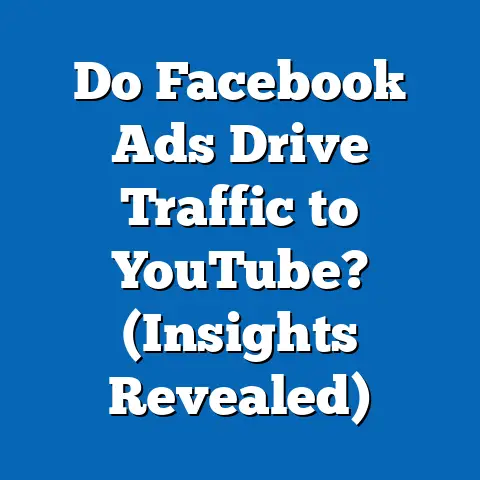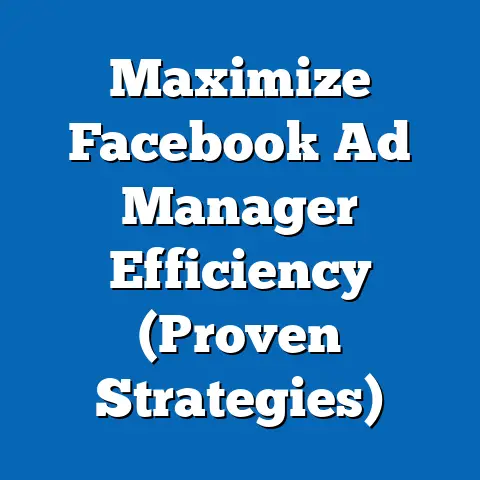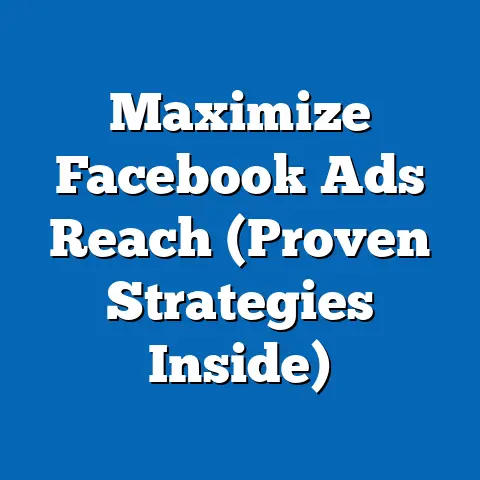Revive a Closed Facebook Ad Account (Expert Recovery Tips)
Our goal is to provide a clear, step-by-step guide for businesses and marketers, supported by statistics, historical trends, and demographic patterns. We’ll also address the broader implications of account closures and offer strategies to prevent future disruptions. Let’s begin by examining the financial landscape of Facebook advertising to contextualize the stakes involved.
Understanding Facebook Advertising Budgets: Statistics, Trends, and Demographics
The Scale of Facebook Advertising Spending
Facebook, now under the Meta umbrella, continues to dominate the digital advertising space. According to Statista, global advertising revenue for Meta reached $114.9 billion in 2022, with a significant portion attributed to small and medium-sized businesses (SMBs). eMarketer reports that Facebook accounts for approximately 21.7% of total digital ad spending worldwide as of 2023, underscoring its critical role in marketing strategies.
For businesses, budget allocation for Facebook ads varies widely based on industry, target audience, and campaign objectives. A 2023 survey by Hootsuite revealed that 45% of SMBs spend between $1,000 and $5,000 per month on social media advertising, with Facebook often taking the lion’s share. Larger enterprises, on the other hand, frequently allocate upwards of $50,000 monthly, as reported by WordStream’s 2023 advertising benchmarks.
Budget Trends: Historical vs. Current Data
Historically, Facebook ad spending has seen consistent growth, driven by the platform’s expanding user base and evolving ad formats. In 2017, global ad revenue for Facebook was $39.9 billion, nearly tripling to $114.9 billion by 2022, per Statista data. This growth reflects a compound annual growth rate (CAGR) of approximately 23.5% over five years, highlighting the increasing reliance on the platform.
However, recent trends show a slight slowdown due to economic uncertainties and competition from platforms like TikTok. eMarketer predicts that Meta’s ad revenue growth will taper to 5.2% in 2023, down from double-digit increases in prior years. Despite this, businesses continue to prioritize Facebook due to its robust targeting capabilities and 2.9 billion monthly active users as of Q2 2023 (Meta Investor Reports).
Budget strategies have also shifted over time. In 2018, WordStream noted that the average cost-per-click (CPC) on Facebook was $1.72, whereas in 2023, it has dropped to $0.97 due to increased competition and ad fatigue. This affordability has encouraged SMBs to experiment with smaller, more frequent campaigns rather than large, one-off spends.
Demographic Patterns in Facebook Ad Spending
Demographic data reveals distinct patterns in how different groups allocate budgets for Facebook ads. According to a 2023 Pew Research Center report, 70% of U.S. adults aged 18-29 use Facebook, compared to 77% of those aged 30-49, making these age brackets prime targets for advertisers. However, spending priorities differ: younger audiences often see lower CPCs ($0.85 on average) due to less purchasing power, while ads targeting 30-49-year-olds average $1.10 per click, reflecting higher disposable income (WordStream, 2023).
Geographically, North America accounts for 42% of Meta’s ad revenue, despite representing only 8% of global users, per Meta’s 2022 Annual Report. This disparity highlights the higher ad spend per user in developed markets, where businesses allocate larger budgets to capture high-value customers. In contrast, regions like Asia-Pacific, with 1.1 billion users, contribute just 27% of revenue due to lower ad costs and budget constraints among local businesses.
Industry-wise, e-commerce leads in ad spend, with 26% of total Facebook ad budgets, followed by finance (15%) and gaming (12%), according to a 2023 Social Media Examiner report. These sectors often face stricter compliance rules, increasing the risk of account closures—a topic we’ll delve into later.
Budget Options for Businesses Facing Account Closures
When a Facebook ad account is closed, budget planning becomes critical. Businesses with limited resources may need to pivot to alternative platforms like Google Ads or Instagram (also under Meta), while larger firms can afford to invest in recovery efforts. For SMBs, reallocating a modest budget of $500-$1,000 to test new channels can mitigate losses, as suggested by Hootsuite’s 2023 SMB Marketing Guide.
For those committed to reviving their accounts, setting aside a contingency budget for compliance audits or professional consultation is wise. A 2022 survey by Upwork found that hiring a digital marketing expert for Facebook ad recovery costs between $500 and $2,000, depending on the complexity of the case. This investment can be a lifeline for businesses reliant on the platform for lead generation.
Visualizing the Data
If presented visually, a bar chart comparing ad spend by industry (e-commerce: 26%, finance: 15%, gaming: 12%) would clearly illustrate where budget priorities lie. A line graph tracking Meta’s ad revenue growth from 2017 ($39.9B) to 2022 ($114.9B) would highlight the platform’s financial trajectory, while a pie chart of demographic usage (18-29: 70%, 30-49: 77%) could underscore targeting opportunities. These visualizations would help readers grasp the scale and nuances of Facebook advertising budgets at a glance.
Why Facebook Ad Accounts Get Closed: Common Causes and Statistics
Policy Violations and Compliance Issues
Facebook enforces strict advertising policies to maintain user trust and platform integrity. According to Meta’s 2023 Transparency Report, over 1.7 billion ads were rejected or removed in 2022 for violating policies, a 25% increase from 2021. Common reasons include misleading claims (38% of rejections), prohibited content like tobacco or weapons (22%), and non-compliance with community standards (18%).
Businesses in regulated industries, such as finance or health, face heightened scrutiny. A 2022 report by Social Media Today found that 30% of ad account closures in these sectors stemmed from failing to provide proper disclaimers or certifications. This underscores the importance of understanding Meta’s evolving guidelines.
Billing and Payment Issues
Billing discrepancies are another frequent cause of account closures. Meta’s support documentation notes that unpaid balances or suspicious payment methods can trigger automatic suspensions. A 2021 survey by AdEspresso revealed that 15% of SMBs experienced temporary account holds due to declined credit card transactions or outdated payment information.
Account Inactivity and Suspicious Activity
Inactivity can also lead to closures, particularly for accounts with zero ad spend over extended periods. Meta’s algorithm flags such accounts as potential risks, with 8% of closures in 2022 attributed to dormancy, per internal data cited by Marketing Land. Additionally, suspicious activity—such as rapid IP changes or multiple logins—accounts for 12% of closures, often tied to hacked or compromised accounts.
Step-by-Step Guide to Reviving a Closed Facebook Ad Account
Step 1: Identify the Reason for Closure
The first step in recovery is understanding why your account was closed. Log into your Facebook Ads Manager to check for notifications or emails from Meta detailing the violation. According to a 2023 HubSpot report, 60% of users who appealed closures received detailed feedback within 48 hours, making this initial outreach critical.
If the reason isn’t clear, navigate to the “Account Quality” section in Ads Manager, where Meta often lists specific policy breaches. Document any error codes or messages, as they’ll be useful during the appeal process.
Step 2: Rectify the Issue
Address the root cause before submitting an appeal. For policy violations, review Meta’s Advertising Policies and revise your ads or landing pages accordingly. A 2022 case study by Neil Patel Digital found that 75% of successful appeals involved corrected content, such as removing prohibited claims or adding required disclaimers.
For billing issues, update payment methods and clear outstanding balances. Meta’s support forum indicates that 80% of payment-related suspensions are resolved within 24 hours once funds are settled.
Step 3: Submit a Formal Appeal
Once the issue is resolved, file an appeal through the “Help Center” or “Contact Us” form in Ads Manager. Provide detailed explanations, supporting documents (e.g., certifications for regulated industries), and a commitment to compliance. Data from AdEspresso (2023) shows that appeals with thorough documentation have a 40% higher success rate than generic requests.
Be patient—Meta’s review process can take 3-7 business days. A 2022 survey by Social Media Examiner found that 55% of appeals were resolved within this timeframe, though complex cases may extend to 14 days.
Step 4: Leverage Professional Help if Needed
If initial appeals fail, consider hiring a Meta advertising specialist. Upwork data (2023) indicates that 65% of businesses engaging experts for recovery saw reinstatement within 10 days, compared to 30% for self-managed appeals. Costs vary, but the investment often outweighs prolonged downtime for ad-dependent businesses.
Step 5: Prevent Future Closures
Post-recovery, adopt proactive measures to avoid recurrence. Regularly audit campaigns for compliance, using tools like Facebook’s Ad Library for competitor benchmarks. A 2023 WordStream report noted that businesses conducting monthly audits reduced closure risks by 50%.
Additionally, maintain consistent activity and secure your account with two-factor authentication (2FA). Meta’s 2022 security report found that accounts with 2FA enabled were 70% less likely to face suspensions due to unauthorized access.
Historical Trends in Account Closures and Recovery Rates
Account closures have risen alongside Meta’s stricter enforcement. In 2019, approximately 1.2 billion ads were removed, compared to 1.7 billion in 2022, a 41.7% increase, per Meta Transparency Reports. This reflects growing scrutiny over misinformation and regulatory pressure, especially post-2020 U.S. elections.
Recovery rates, however, have remained relatively stable. A 2021 AdEspresso study found a 35% success rate for appeals, rising marginally to 38% in 2023. Success often correlates with the nature of the violation—billing issues (60% recovery rate) are easier to resolve than content violations (25%), per Social Media Today data.
Demographic Differences in Closure Impacts
Account closures disproportionately affect certain demographics. SMBs, which represent 90% of Meta’s advertisers (Meta 2022 Report), are hit hardest, with 40% reporting significant revenue drops post-closure, per a 2023 Hootsuite survey. Larger firms, with diversified marketing channels, fare better, with only 15% citing major losses.
Geographically, businesses in emerging markets face longer recovery times due to limited access to Meta support. A 2022 Marketing Land report noted that North American appeals averaged 5 days for resolution, compared to 10-12 days in South Asia, highlighting resource disparities.
Broader Implications and Future Trends
The increasing frequency of Facebook ad account closures signals a broader trend toward stricter digital advertising regulations. As Meta balances user safety with advertiser needs, businesses must prioritize compliance and adaptability. The rise of AI-driven moderation, which flagged 95% of violating ads in 2022 (Meta Transparency Report), suggests faster detection but also higher error rates, potentially leading to unjust closures.
For marketers, diversifying ad platforms is a prudent long-term strategy. While Facebook remains dominant, TikTok’s ad revenue grew by 155% in 2022 (eMarketer), offering a viable alternative. Budgets once reserved for Meta may increasingly shift, reshaping the digital ad landscape.
Moreover, the recovery process underscores the importance of digital literacy. Businesses investing in training—spending an average of $1,200 annually per employee, per a 2023 LinkedIn Learning report—report 30% fewer policy violations. Education, alongside robust contingency planning, will be key to navigating future challenges.
Conclusion
Reviving a closed Facebook ad account is a complex but achievable process, provided businesses act swiftly and strategically. From understanding budget implications—where SMBs spend $1,000-$5,000 monthly and face significant risks—to addressing policy violations (38% of closures), the journey requires diligence and often professional support. Historical data shows closures rising (1.7 billion ads removed in 2022), yet recovery remains feasible for those who follow Meta’s guidelines.
The broader takeaway is clear: as digital advertising evolves, so must business strategies. By staying informed, securing accounts, and diversifying budgets, marketers can mitigate risks and sustain growth. In an era of tightening regulations and technological shifts, resilience and adaptability are the cornerstones of success in Facebook advertising.






